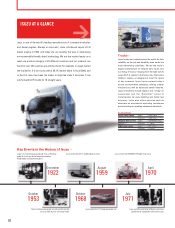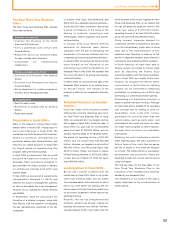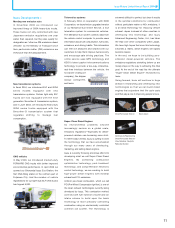Isuzu 2004 Annual Report Download - page 9
Download and view the complete annual report
Please find page 9 of the 2004 Isuzu annual report below. You can navigate through the pages in the report by either clicking on the pages listed below, or by using the keyword search tool below to find specific information within the annual report.
09
Isuzu Motors Limited Annual Report 2004
The New Three-Year Business
Plan
>>
The New Three-Year Business Plan includes
three main elements:
Eliminate uncertainties
• Overhaul the structure of the North
American SUV business
• Form a powertrain joint venture with
General Motors
• Reduce the size of our workforce mainly
through voluntary early retirement
• Consolidate our manufacturing
infrastructure
Enhance management control
• Executive Vice President from General
Motors
• Executive Vice President from Mizuho
Corporate Bank
• Set up department to oversee progress on
the New Three-Year Business Plan
Recapitalization
• Debt-for-equity swap
• Retirement of shares held by General
Motors
• Raise fresh capital
Steps taken in fiscal 2004
>>
Many of the measures outlined above were
already taken in fiscal 2003, helping Isuzu to
post record earnings in fiscal 2004. We
overhauled our North American SUV business,
shrank our workforce, strengthened our
powertrain alliance with General Motors, and
improved our capital structure. In fiscal 2004
we forged ahead on implementing this
program, taking the following steps:
In April 2003 we announced that we would
postpone the planned relocation of our
Kawasaki Plant operations designed to
accommodate the sharp increase in demand
for commercial vehicles both within and
outside Japan.
In May 2003 we announced a departmental
reorganization designed to clarify and
optimize the scope of management authority
as well as strengthen the local management
structure for our operations in North America
and ASEAN.
In September 2003 we announced the
formation of a holding company, along with
Hino Motors, with the objective of integrating
the bus manufacturing operations of the two
companies.
In October 2003 Isuzu, General Motors, and
GM’s other two Japanese business partners—
Suzuki and Fuji Heavy Industries—announced
a series of initiatives in the areas of the
sharing of products, powertrains and
technologies; market expansion and growth;
and purchasing.
In January 2004 Isuzu Motors America
absorbed its American Isuzu Motors
subsidiary with the aim of eliminating the
duplication of functions between the two
companies and improving business efficiency.
In January 2004 we announced that we would
move forward on the relocation of the
manufacturing functions handled by our
Kawasaki Plant in May 2004. We estimate that
the move will result in an annual cost savings
of about ¥5 billion.
In March 2004 we announced the sale of the
Kawasaki Plant property to an outside buyer
for ¥15,371 million. The transfer of the
property is slated to be completed in February
2005.
Actual performance versus plan
targets
>>
Isuzu has made solid progress towards
attaining the concrete objectives laid out in
our New Three-Year Business Plan. In fiscal
2003, we exceeded all of our targets, and we
did so again in fiscal 2004. Under the plan, in
fiscal 2004 our goal was for consolidated
sales of at least ¥1,250,000 million, and we
actually reported sales of ¥1,430,333 million.
We aimed for operating income of ¥50,000
million, and our actual result was ¥84,490
million. Likewise, we targeted a net profit of
¥35,000 million, and the actual figure was
¥54,713 million. Finally, we hoped to reduce
interest-bearing liabilities to ¥510,000 million
or less, and as of March 31, 2004 the figure
was ¥452,600 million.
Looking ahead to fiscal 2005
>>
But we can’t content ourselves with the
results seen in fiscal 2004. Most of our profits
came from domestic sales, and our profits
from overseas sales—which account for about
half of our total sales—are lacking. We are
keenly aware of the fact that there is still room
for us to exert ourselves to further improve our
earnings structure.
Recently, the yen has strengthened and
domestic demand has slowed, making the
business environment more difficult. However,
forecast demand is still much higher than the
levels foreseen when we put together the New
Three-Year Business Plan, so we believe that
we can still attain the goals set forth for this
fiscal year: sales of ¥1,270,000 million,
operating income of at least ¥60,000 million
and a net profit of at least ¥50,000 million.
Going forward, Japanese demand for
commercial vehicles is expected to fall back
from the extraordinary levels seen in fiscal
2004 due to the implementation of new
emissions rules. Therefore, to make up for this
decline in Japanese demand, Isuzu intends to
redouble its truck marketing efforts overseas.
In North America, we have been able to
sharply reduce our losses by taking steps
such as dissolving the Subaru Isuzu
Automotive alliance with Fuji Heavy Industries,
and in fiscal 2004 we roughly broke even.
However, we recognize the need for further
improvement in North America. Moving
forward, we are committed to enhancing
profitability by breaking even in SUVs and
developing our commercial vehicle business.
Streamlining our distribution structure in
Japan is another key issue for Isuzu. Although
we have been able to steadily lift the operating
cost coverage ratio by working to cover our
dealerships’ fixed costs with revenue
generated from activities other than new
vehicle sales—such as parts sales, and
maintenance and repair services—we have
not made much progress on debt reduction.
We must strive to recover our receivables
more quickly.
Reducing the cost of materials is another
major lingering issue. We want customers to
think in terms of how much they are paying
per liter of engine or how much per kilogram
for a truck. The unified efforts of purchasing,
development and production teams are
beginning to bear fruit, but we need to look at
costs once again.
The final key issue for the final phase of our
New Three-Year Business Plan is the
relocation of the manufacturing functions
handled by our Kawasaki Plant.
The attainment of our goals for this year is
largely dependent on the overall success of
these projects.






















